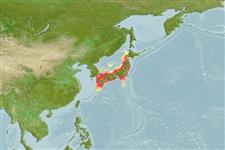Environment: milieu / climate zone / depth range / distribution range
Écologie
marin; océanodrome (Ref. 51243); profondeur 0 - 275 m (Ref. 54927), usually 50 - 275 m (Ref. 54927). Tropical; 46°N - 13°N, 105°E - 148°E
Northwest Pacific: southern Japan, Korean Peninsula to the East China Sea. Pacific Ocean off the coast of southeast Asia.
Length at first maturity / Taille / Poids / Âge
Maturity: Lm 19.0, range 18 - 20 cm
Max length : 50.0 cm TL mâle / non sexé; (Ref. 56557); common length : 35.0 cm TL mâle / non sexé; (Ref. 56557); poids max. publié: 660.00 g (Ref. 40637); âge max. reporté: 12 années (Ref. 56557)
Épines dorsales (Total): 9; Rayons mous dorsaux (Total): 30-35; Épines anales 3; Rayons mous anaux: 26 - 30; Vertèbres: 24. Species with no finlets and the entire lateral line with scutes (69-73) (Ref. 41299).
Adults occur on continental waters (Ref. 41299). Pelagic (Ref. 52947). Juveniles associate with drifting seaweed (Ref. 12114, 12115).
Masuda, H., K. Amaoka, C. Araga, T. Uyeno and T. Yoshino, 1984. The fishes of the Japanese Archipelago. Vol. 1. Tokai University Press, Tokyo, Japan. 437 p. (text). (Ref. 559)
Statut dans la liste rouge de l'IUCN (Ref. 130435)
Menace pour l'homme
Harmless
Utilisations par l'homme
Pêcheries: hautement commercial; Aquaculture: commercial
Outils
Articles particuliers
Télécharger en XML
Sources Internet
Estimates based on models
Preferred temperature (Ref.
123201): 1.8 - 22, mean 13.8 °C (based on 75 cells).
Phylogenetic diversity index (Ref.
82804): PD
50 = 0.5001 [Uniqueness, from 0.5 = low to 2.0 = high].
Bayesian length-weight: a=0.01072 (0.00875 - 0.01312), b=2.97 (2.94 - 3.00), in cm total length, based on LWR estimates for this species (Ref.
93245).
Niveau trophique (Ref.
69278): 3.4 ±0.45 se; based on food items.
Résilience (Ref.
120179): Milieu, temps minimum de doublement de population : 1,4 à 4,4 années (K=0.14-0.38; tmax=6).
Prior r = 0.75, 95% CL = 0.49 - 1.12, Based on 2 stock assessments.
Fishing Vulnerability (Ref.
59153): Low to moderate vulnerability (34 of 100).
Climate Vulnerability (Ref.
125649): Low vulnerability (20 of 100).
Nutrients (Ref.
124155): Calcium = 386 [198, 652] mg/100g; Iron = 4.01 [2.35, 6.81] mg/100g; Protein = 18.6 [17.7, 19.4] %; Omega3 = 0.208 [0.126, 0.330] g/100g; Selenium = 50.3 [30.5, 90.1] μg/100g; VitaminA = 28 [7, 124] μg/100g; Zinc = 3 [2, 4] mg/100g (wet weight);
